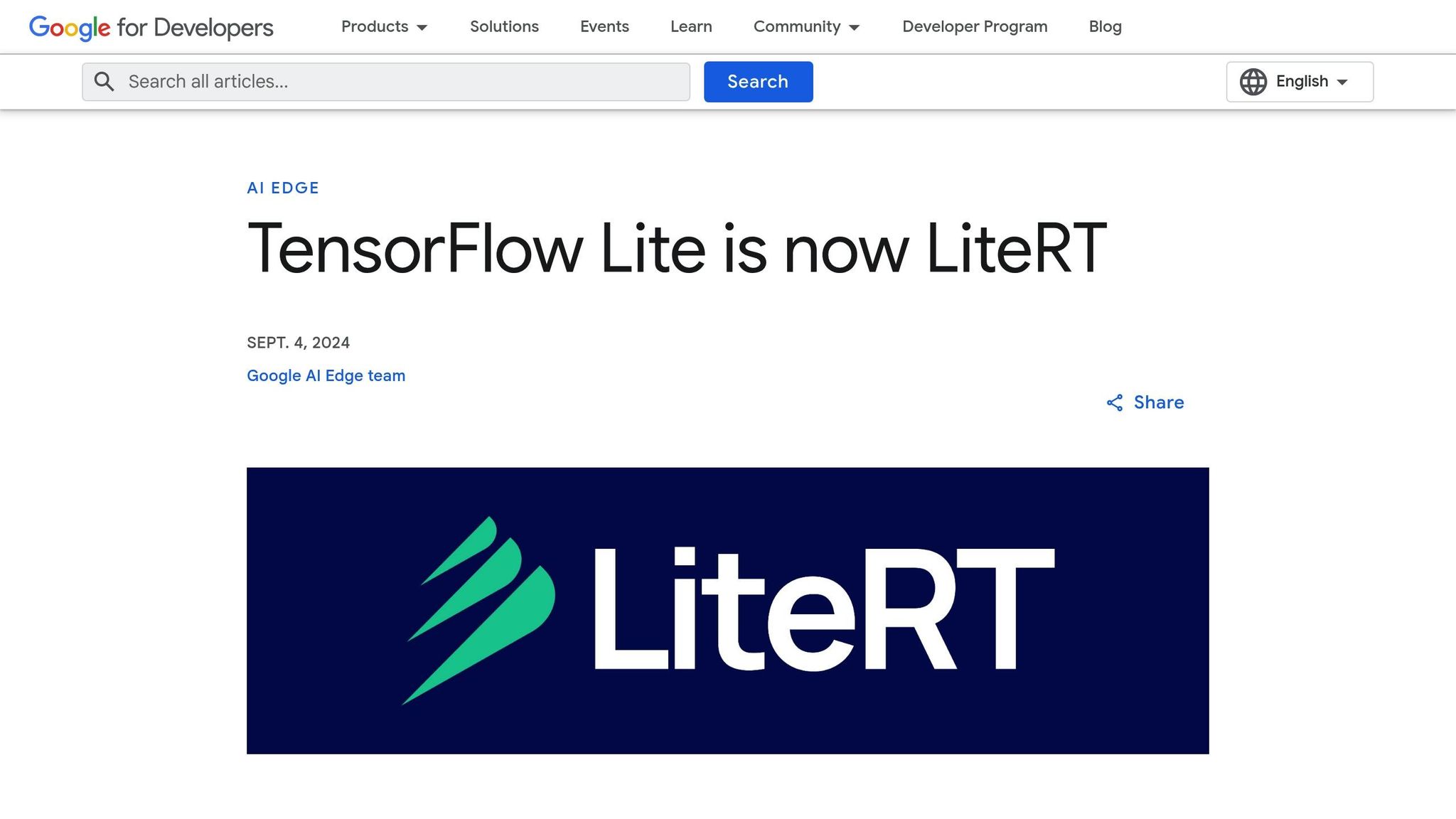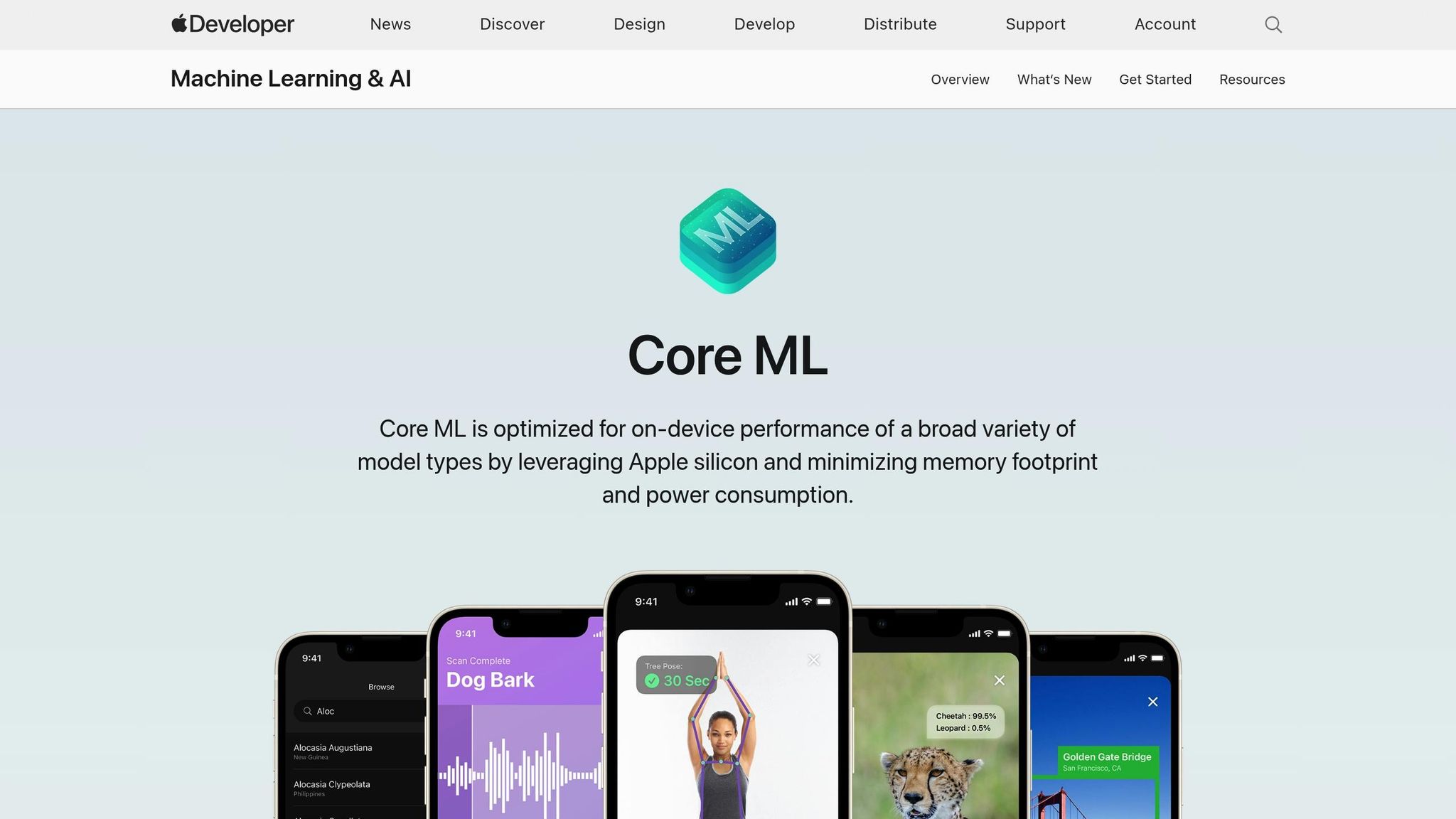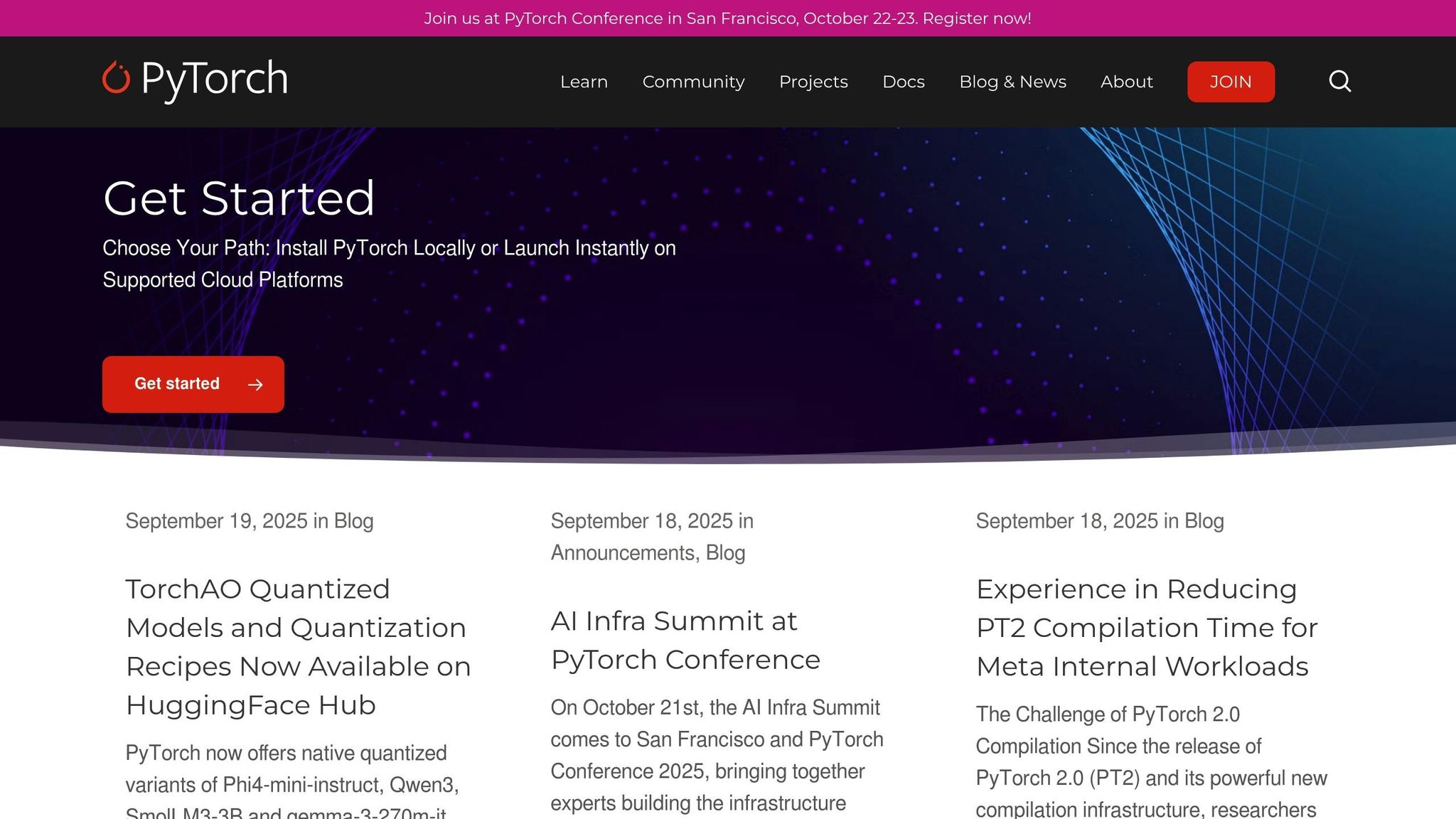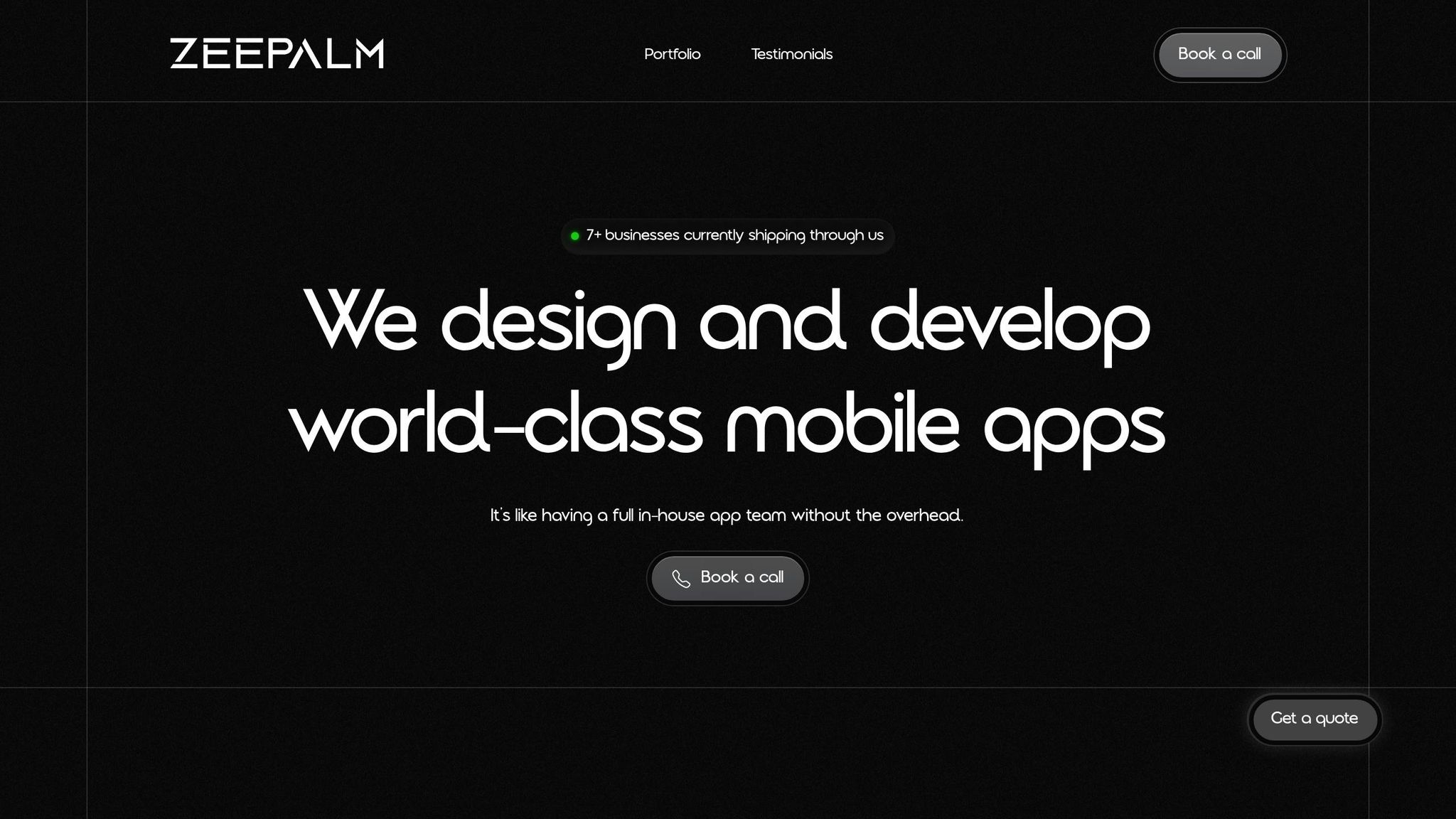AI is transforming mobile app security in 2025 by addressing increasingly complex threats like advanced persistent attacks and data breaches. It enables real-time threat detection, behavioral monitoring, and automated responses, ensuring apps stay secure against evolving risks. Key tools include TensorFlow Lite, Core ML 5, PyTorch Mobile, Snyk, and Zee Palm, each offering unique features for various platforms and industries. Early integration of AI-driven security into app development reduces vulnerabilities, lowers long-term costs, and meets strict regulations like GDPR 2.0 and HIPAA. Choosing the right tool depends on your app's platform, security needs, and compliance requirements.
Key Insights:
- AI detects threats faster and more accurately than traditional methods.
- Tools like TensorFlow Lite and Core ML 5 prioritize on-device processing for privacy.
- Custom solutions like Zee Palm address specific app security challenges.
- Regular updates and retraining of AI models are crucial to staying ahead of threats.
- Compliance with regulations (e.g., GDPR 2.0, HIPAA) is critical for sensitive apps.
AI-driven security is no longer optional - it’s a must-have for protecting user data and maintaining trust in today’s digital landscape.
The Future of Application Security: 3 Ways Agentic AI is Changing Security in 2025
AI-Powered Tools for Mobile App Security
AI-driven tools are transforming mobile app security by offering advanced features like fast threat detection, secure data handling, and uninterrupted protection - even when offline. Here's a look at some standout tools that bolster mobile app security.
TensorFlow Lite

TensorFlow Lite, developed by Google, is a go-to solution for efficient on-device machine learning. It processes data locally, ensuring user privacy while delivering low-latency performance. Plus, its offline capabilities mean your app remains protected even without an internet connection.
Core ML 5

Apple's Core ML 5 is built to work seamlessly with iOS devices, leveraging the Neural Engine for powerful AI processing. It integrates with iOS security features, such as biometric authentication, and ensures smooth performance across various iPhone and iPad models.
PyTorch Mobile

PyTorch Mobile offers flexible, cross-platform support for building and deploying mobile security solutions. Its modular approach allows developers to create custom security models that can quickly adapt to new and evolving threats.
Snyk

Snyk focuses on securing mobile app development with AI-powered static code analysis. It scans codebases for vulnerabilities early in the development process, helping teams address risks before they reach production.
Zee Palm

Zee Palm stands out for its expertise in AI security integrations for mobile apps. With over a decade of experience and more than 100 projects completed by its 13-member team, Zee Palm specializes in addressing specific security challenges. By combining various AI frameworks, it develops multi-layered security solutions tailored to each app's unique needs, ensuring strong protection against complex threats.
Core Security Features Enabled by AI
AI is transforming mobile app security by shifting the focus from reactive to proactive defenses. With its ability to adapt and learn in real time, AI introduces advanced protection methods that go beyond traditional security measures. Here's a closer look at how AI strengthens key security features in mobile applications.
Real-Time Behavioral Monitoring
AI takes user monitoring to the next level by establishing a baseline for typical behavior - things like typing speed, touch pressure, and navigation habits. Any unusual activity, such as logging in at odd hours or entering rapid, unusual keystrokes, triggers an alert for potential security risks. This constant vigilance helps detect breaches as they happen.
Biometric and Behavioral Authentication
AI enhances authentication by combining biometrics with behavioral analysis. For instance, facial recognition now includes liveness detection to ensure it's not fooled by photos, and voice authentication analyzes subtle vocal patterns. On top of that, AI tracks behavioral cues like how a person walks or handles their device, offering continuous identity verification.
Automated Penetration Testing and Threat Simulation
AI automates penetration testing by simulating attack scenarios round-the-clock. It scans code, network activity, and user interfaces for weaknesses, even identifying hard-to-spot zero-day vulnerabilities. Plus, it ensures compliance with industry standards like PCI DSS and HIPAA without manual intervention, streamlining the process while maintaining robust security.
sbb-itb-8abf120
AI Tools Comparison: Pros and Cons
Picking the right AI tool for mobile app security isn't just about ticking off a list of features - it’s about finding what works best for your specific needs, limitations, and future plans. Each tool has its own strengths and trade-offs that can shape your overall security strategy.
AI Tools Comparison Table
| Tool | Platform Support | Key Security Strengths | Performance | Best For | Main Limitations |
|---|---|---|---|---|---|
| TensorFlow Lite | Android, iOS, Embedded | Hardware acceleration, offline processing, model quantization | GPU inference 3x faster than CPU (11.18ms vs. 28.58ms) | Cross-platform apps, real-time threat detection | Complex static graph conversion; challenging debugging |
| PyTorch Mobile | Android, iOS | Dynamic graphs, custom operators, flexible debugging | Larger binary size (19.6–24.8MB more than TensorFlow Lite) | Research projects, evolving security models | Less mature GPU support; larger app footprint |
| Core ML 5 | iOS only | Native Apple integration, minimal memory footprint, power efficiency | Optimized for Apple hardware with low battery drain | iOS-exclusive apps, seamless Apple ecosystem integration | Limited to basic tasks and iOS platform |
| Snyk | Cross-platform | HIPAA compliance, prompt-injection defenses, real-time dependency monitoring | Continuous scanning with real-time dependency checks | Healthcare apps, enterprise security | Requires integration into development workflows |
| Zee Palm | Custom Solutions | End-to-end security architecture, extensive expertise, regulatory compliance | Tailored performance optimization | Complex security requirements in regulated industries | Custom development timeline |
How to Choose the Right Tool
The table above highlights the main differences, but the real challenge is narrowing down your choice based on performance, platform compatibility, expertise, and budget.
Your tool should align with your app’s performance needs and platform strategy. A striking statistic: in 2025, 42% of businesses dropped their AI projects because the tools didn’t meet their needs, and nearly half of promising AI initiatives failed due to unexpected costs after testing.
For AR/VR apps where response times under 20ms are critical, TensorFlow Lite's GPU acceleration - three times faster than CPU processing - becomes a game-changer.
Platform compatibility is another key factor. Core ML 5 delivers exceptional performance on iOS devices but is locked into Apple’s ecosystem. Meanwhile, PyTorch Mobile offers flexibility across platforms but comes with a larger binary size. TensorFlow Lite strikes a balance between cross-platform support and high performance.
Privacy laws like GDPR 2.0, which emphasize on-device data processing, also influence tool selection. Tools like TensorFlow Lite and Core ML 5 are well-suited for these requirements. With 78% of health and finance apps now requiring on-device processing, this trend cannot be ignored.
Team expertise plays a big role too. If your team lacks advanced AI skills, simpler options like Snyk or a full-service solution from Zee Palm could be more practical. These tools integrate seamlessly into workflows or offer custom-built solutions, reducing the need for deep technical knowledge.
Finally, think about long-term costs and scalability. Many projects stumble because of unforeseen scaling expenses. Predictable on-device costs with TensorFlow Lite and Core ML 5 can help manage budgets as your app grows.
For healthcare apps, Snyk’s HIPAA compliance makes it a strong choice, while financial apps might benefit from TensorFlow Lite’s real-time fraud detection capabilities. On the other hand, gaming and social apps could leverage PyTorch Mobile’s flexibility to iterate features quickly.
Best Practices for AI Security Integration
Leveraging tools like TensorFlow Lite and Snyk is just the start when it comes to AI security. Ensuring your app remains secure requires a solid, adaptable foundation that evolves alongside emerging threats. The difference between a secure app and one that's vulnerable often lies in how effectively you implement and maintain your AI security measures.
Continuous Testing and Monitoring
AI security isn't a "set it and forget it" process - it requires constant attention. Cyber threats evolve daily, and your AI system must stay a step ahead. Real-time monitoring is essential to track both your AI model's performance and the security threats it detects.
Automated testing pipelines are crucial for identifying vulnerabilities before your app goes live. For high-risk applications, retraining AI models every 30–60 days is a smart practice.
One common challenge is model drift, where an AI model's performance declines over time due to changes in the threat landscape. Keep an eye on metrics like detection accuracy, false positives, and response times. If performance drops by more than 10%, it's time to retrain the model.
Feedback loops are another key element. When your app encounters a new type of attack, feed that data back into your training process. This ensures your AI learns from actual threats, not just hypothetical scenarios.
Logging is also critical. Secure, compliant logs can help you analyze attack patterns and refine your defenses. These logs are particularly useful for meeting regulatory requirements while improving your AI model's overall effectiveness.
Meeting Regulatory Standards
Privacy laws like GDPR 2.0 have made on-device AI processing a necessity for many apps, especially those handling personal data. Tools like TensorFlow Lite and Core ML 5 enable efficient on-device processing, reducing the need to send sensitive information to external servers.
For healthcare apps, compliance with HIPAA is non-negotiable. Your AI security setup must include robust encryption, strict access controls, and detailed audit trails. Tools like Snyk can assist by offering built-in compliance features tailored for healthcare needs.
Financial applications face their own set of challenges under regulations like PCI DSS and SOX. Fraud detection systems must maintain detailed logs of flagged transactions and provide clear explanations for their decisions. This "explainable AI" requirement means black-box models are often unsuitable for these use cases.
Thorough documentation is another must. Regulators expect clear evidence that you're actively safeguarding user data and have plans in place to handle security incidents. This includes documenting your model training processes, data handling policies, and incident response protocols.
Data residency laws, which vary by state, can also influence your choice of AI tools. Some regulations mandate that user data remain within specific geographic boundaries. This means you might need to prioritize on-device processing over cloud-based solutions, depending on where your users are located.
Working with Expert Development Teams
AI security is too complex to tackle alone. The ever-changing threat landscape and the intricacies of AI require specialized expertise that many in-house teams lack.
Experienced partners, like Zee Palm, can deliver tailored security solutions designed to meet both technical and regulatory demands.
When choosing a development team, look for those with a deep understanding of your specific industry. For instance, a healthcare app will have very different security needs compared to a social media platform. Teams with relevant experience can design solutions that address your unique challenges.
Custom AI security solutions often outperform generic, off-the-shelf tools. By focusing on your app's specific threat model and user behavior, these solutions reduce false positives and improve detection accuracy for the threats that matter most.
The timeline for integrating custom AI security typically ranges from 8 to 16 weeks, depending on complexity and compliance requirements. While this may seem longer than deploying a ready-made solution, the long-term benefits of a tailored system usually outweigh the initial investment.
Consider establishing a long-term partnership with your development team. AI security isn't static - it requires ongoing updates and refinements as new threats emerge. Having a dedicated team that understands your app's architecture and security needs can make future adjustments faster and more effective.
Conclusion
Key Takeaways
AI has reshaped mobile app security by moving defenses from a reactive stance to a predictive one. Tools like TensorFlow Lite, Core ML 5, PyTorch Mobile, and Snyk bring distinct advantages, such as real-time behavior analysis and automated threat detection. These features aren't just add-ons - they're critical for building a strong and reliable security framework.
This shift to proactive defense allows organizations to safeguard user data more effectively by anticipating threats and fortifying systems before attackers can exploit vulnerabilities. To maintain this edge, AI security systems need constant updates, retraining, and performance evaluations to counter increasingly sophisticated cyberattacks.
Final Thoughts
The message is clear: integrating AI into security frameworks is no longer optional. As Evangelist Apps aptly stated:
"As businesses continue to invest in Mobile App Development, integrating AI into security frameworks will no longer be optional it will be essential for survival and success in the digital economy."
The rapid evolution of cyber threats underscores the urgency of this approach. In the ongoing battle between attackers and defenders, standing still is not an option.
Collaborating with seasoned development teams like Zee Palm can streamline the process of implementing AI-driven security measures. With expertise in AI, healthcare applications, and custom development, they can help you design security solutions tailored to your app's unique needs and risks.
AI is already at the forefront of mobile app security. It's detecting fraud, authenticating users dynamically, and safeguarding privacy with advanced techniques like federated learning. Companies that embrace these technologies will be better equipped to thrive in the digital age, while those that hesitate risk falling victim to the next big security breach.
Your users rely on you to protect their data, privacy, and financial security. By leveraging AI-powered tools, you can earn and maintain that trust while staying ahead of the ever-changing threat landscape.
FAQs
How does AI improve mobile app security compared to traditional methods?
AI is transforming mobile app security by leveraging real-time threat detection and adaptive learning to tackle risks in ways that older, static systems simply can't match. Instead of relying on fixed rules, AI evolves by studying patterns and behaviors, allowing it to identify new and emerging threats before they cause harm.
One of AI's standout features is its ability to process massive amounts of data at lightning speed, spotting anomalies and vulnerabilities far faster - sometimes up to 60% faster - than traditional methods. This not only cuts down on false alarms but also delivers a more flexible and responsive defense against cyber threats. For developers, this means stronger protection for their apps and user data without unnecessary delays or inefficiencies.
What should I look for in an AI tool to enhance mobile app security?
When choosing an AI tool for mobile app security, look for one that can work seamlessly with your current systems. It should also provide key security features like data encryption, access controls, and adherence to industry regulations. Make sure the tool includes real-time threat detection, the ability to grow with your needs, and secure data handling methods such as anonymization and tokenization.
Focusing on these capabilities will help safeguard your mobile app from emerging threats while ensuring a safe experience for your users.
How do AI-powered security tools help meet compliance requirements like GDPR 2.0 and HIPAA?
AI-powered security tools make it easier to meet regulatory requirements, such as GDPR 2.0 and HIPAA, by automating essential data protection tasks. They help maintain privacy standards, ensure secure data management, and reduce the chances of unauthorized access.
Key features like encryption, real-time monitoring, and audit trails ensure that sensitive data is handled and stored in compliance with regulatory guidelines. By simplifying these compliance processes, developers can concentrate on creating secure, user-friendly applications while lowering the risk of expensive violations.





